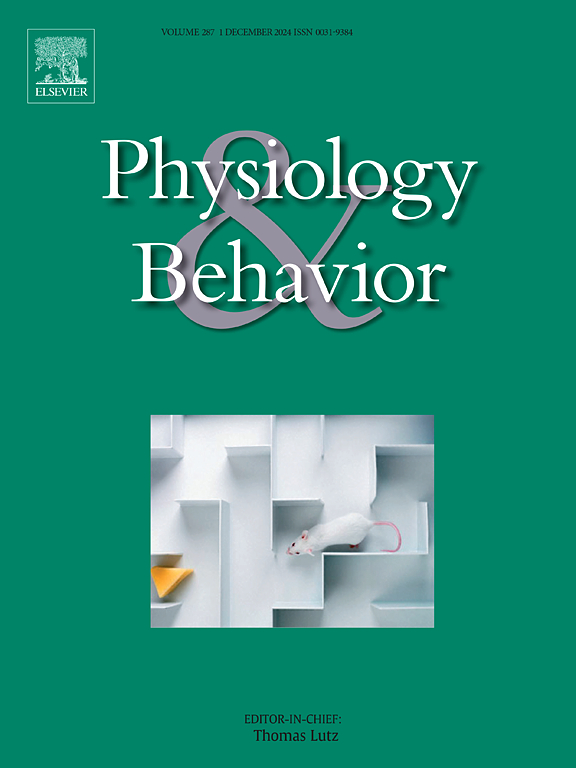中枢内啡肽表达和食欲调节的性别差异
IF 2.5
3区 医学
Q2 BEHAVIORAL SCIENCES
引用次数: 0
摘要
神经胶质细胞在解剖学和生理学上表现出固有的两性二态性,并作为全身能量稳态的关键调节器,可能导致食欲和体重控制的性别差异。内啡肽是神经胶质产生的信号分子,由亲本蛋白地西泮结合抑制剂(DBI)组成,DBI与厌氧肽octadecaneuropepeptide (ODN)结合。DBI的表达在后脑和下丘脑的背迷走神经复合物(DVC)中特别高,但雌性和雄性在内啡肽信号传导方面是否表现出差异,这可能有助于胶质细胞在能量平衡调节中的性别特异性作用,目前还没有直接研究。我们确定雌性大鼠在喂食或喂食高脂肪食物时对中央ODN的厌食作用更敏感。无论男女,在任何一种饮食中,禁食一夜后,对ODN的进食反应都明显减弱。接下来,我们检查了内源性DBI表达的差异,发现女性在整个DVC和下丘脑第三脑室边界周围有更高水平的DBI免疫荧光蛋白染色。男性注射17β-雌二醇上调了DVC DBI的表达,而女性DVC DBI的表达在不同的发情周期中没有差异,也不受卵巢切除术的影响,这表明中枢DBI转录物存在性别特异性调节。这些数据支持雌性大鼠具有更高的内源性DBI蛋白表达,并且对外源性ODN更敏感,因此可能具有更高的基线内啡肽张力。进一步的工作将确定在神经胶质介导的饮食挑战反应中,内啡肽信号的性别差异的生理相关性。本文章由计算机程序翻译,如有差异,请以英文原文为准。
Sex differences in central endozepine expression and regulation of appetite
Glia display inherent sexual dimorphism in their anatomy and physiology and as key regulators of systemic energy homeostasis, may contribute to sex differences in appetite and body weight control. Endozepines are glial produced signaling molecules consisting of the parent protein diazepam binding inhibitor (DBI) which is cleaved to the anorexigenic peptide octadecaneuropeptide (ODN). DBI expression is particularly high in the dorsal vagal complex (DVC) of the hindbrain and hypothalamus, yet whether females and males exhibit differences in endozepine signaling which may contribute to the sex-specific roles of glia in energy balance regulation has not been directly investigated. We determined that female rats were more sensitive to the anorexic effects of central ODN administration when maintained on either chow or high-fat diet. In both sexes and on either diet, the hypophagic response to ODN was dramatically blunted after an overnight fast. We next examined differences in endogenous DBI expression and found that females had higher levels of DBI immunofluorescent protein staining throughout the DVC and around the 3rd ventricle border of the hypothalamus. While 17β-Estradiol injection in males upregulated DVC DBI expression, female DVC DBI expression was not different across estrous cycle phases nor affected by ovariectomy, suggesting there is sex-specific regulation of central DBI transcripts. These data support that female rats have higher endogenous DBI protein expression and are more sensitive to exogenous ODN and thus may have a higher baseline endozepine tone. Further work will determine the physiological relevance of sex-differences in endozepine signaling in glial-mediated responses to dietary challenges.
求助全文
通过发布文献求助,成功后即可免费获取论文全文。
去求助
来源期刊

Physiology & Behavior
医学-行为科学
CiteScore
5.70
自引率
3.40%
发文量
274
审稿时长
47 days
期刊介绍:
Physiology & Behavior is aimed at the causal physiological mechanisms of behavior and its modulation by environmental factors. The journal invites original reports in the broad area of behavioral and cognitive neuroscience, in which at least one variable is physiological and the primary emphasis and theoretical context are behavioral. The range of subjects includes behavioral neuroendocrinology, psychoneuroimmunology, learning and memory, ingestion, social behavior, and studies related to the mechanisms of psychopathology. Contemporary reviews and theoretical articles are welcomed and the Editors invite such proposals from interested authors.
 求助内容:
求助内容: 应助结果提醒方式:
应助结果提醒方式:


